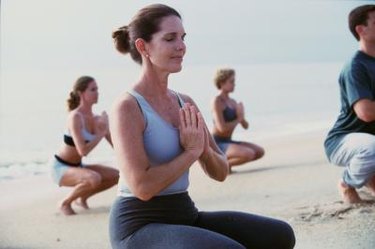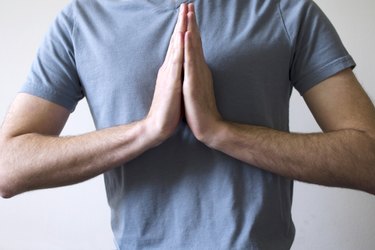
For many people, practicing yoga is much more than a way to get exercise. Rooted in the Indian Vedic tradition (a predecessor of Hinduism), yoga postures are deeply symbolic, and understanding their spiritual meaning offers us a new way to embody them on the mat.
If you've ever heard an instructor or practitioner discuss the spiritual meanings of yoga postures, it's because the traditional practice of yoga is about one thing: creating deeper self-awareness. Here, we break down some of those symbols and metaphors.
Video of the Day
Video of the Day
What Do Yoga Poses Symbolize?
The word "yoga" comes from the Sanskrit root yuj, which means to yoke, or to unite one thing with another, according to the Hindu American Foundation. In Indian Vedic tradition, that's the spiritual purpose of yoga — to help you align with your "true" or "higher" self, soul or spirit (whatever you want to call it).
Through the practice of yoga postures, the traditional belief is that the practitioner can learn to operate with more awareness and balance both on and off the mat, according to the Himalayan Yoga Institute. This deeper awareness is a path to what the ancient yogis called "moksha," or liberation from spiritual suffering.
Contrary to popular belief, yoga poses aren't meant to worship gods. Rather, many of their names have roots in Vedic mythology, which is meant to be symbolic of their spiritual meaning. Here are a few common yoga poses and their meanings.
Monkey Pose (Hanumanasana)

Hanumanasana — monkey or front-split pose — is named after the deity Hanuman, who is illustrated as a monkey. He symbolizes our ability to tame our "monkey mind," or our busy, thinking, worried mind, which the ancient yogis say is a cause of spiritual suffering.
Hanuman's story says we overcome it through devotion to spiritual practices (in this case, yoga and meditation).
The spiritual meaning behind this pose is that being grounded, strong and flexible is what allows us to take leaps of faith in life that move us forward (symbolized by the split legs). This advanced yoga pose requires core strength, flexibility in both legs and a relaxed, stable pelvic floor.
Related Reading
Warrior I and II (Virabhadrasana I and II)
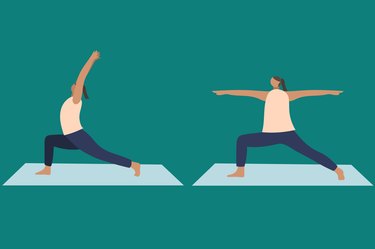
In general, standing yoga poses like the warriors are considered "energizing" or "heating," as long as the heart is above the head in the pose. Energizing postures are associated with spiritual fortitude, determination, action and change.
Virabhadrasana I and II, or warrior I and II, are named after Virabhadra, a warrior from the Vedic texts. These and other standing yoga poses require activation through the feet, legs, hips and core, which give a clue into their spiritual meaning.
In the yogic tradition, it's believed that your core is connected to your "inner fire," also called "agni." Agni is the energy that sparks action, and it's associated with our sense of willpower and spiritual strength, especially in the face of adversity. It's also traditionally tied to our physical core strength and digestion, or our ability to "digest" the circumstances of our life.
Tree Pose (Vrikshasana)
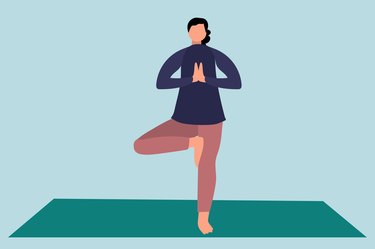
Many standing postures also train our balance, such as tree pose. Tree pose was named after another Vedic story in which a deity sat under a tree, waiting with patience and conviction for a difficult season to pass.
In yoga, tree pose symbolizes our ability to be still and find balance during changes or turbulent times in life. Balancing postures teach us to hone our focus on the present moment so that we remain centered, stable and grounded.
Balancing postures require a combination of leg and hip strength and flexibility, as well as core strength. They're well-known for training proper function in the feet, which in yoga, is connected to our sense of safety, stability and groundedness.
Child's Pose (Balasana)
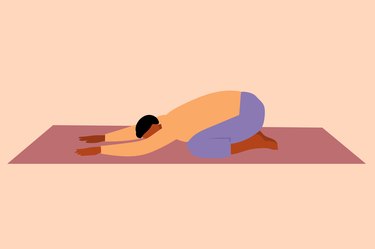
If you've ever felt your stress melt away during a seated forward fold, that's because these poses symbolize release and surrender. While standing poses ignite the flame of action in us, folding postures are about finding peace and acceptance of what is.
Child's pose, for example, isn't just about taking a childlike position. Rather, the spiritual meaning of child's pose has more to do with the vulnerability of a child, who requires nurturing and a safe place to rest their head.
As you fold forward in child's pose with your arms beside you and your forehead resting on the mat, the ground (or earth) is your support, and the muscles of your neck, back and shoulders (common sites of stress) can soften and release.
Folding postures create space between the vertebra in your spine, which creates a sense of relaxation in your nervous system and muscles. For this reason, they're most well-known for helping with stress and anxiety.
Related Reading
Corpse Pose (Savasana)

Some instructors call it the most important pose in yoga, and for good reason: Savasana, or corpse pose, is usually the last pose in a yoga class, and while it looks simple, the spiritual meaning behind it might change the way you practice.
In Savasana, you're meant to lie like a corpse: still, on your back with your arms resting down by your sides and your eyes resting or closed. You'll often hear instructors say the benefits of your practice "sink in" during Savasana, and that's symbolic of the healing and rejuvenating power of conscious rest — of simply being and not doing.

